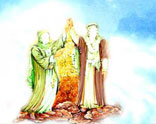History of the twelve imam from the 5th to the 8th centuries
Proving God’s Existence
A very early work entitled Tārīkh al-A’immah or Tārīkh al-Mawālīd wa Wafayāt Ahl al-Bayt (peace be upon them) is available. It mentions the dates of birth and martyrdom of the Infallible Imams (A.S.) on the authority of Imam Baqir (A.S.), Imam Sādiq (A.S.), Imam Rizā (A.S.) and Imam ‘Askarī (A.S.). This book is variously attributed to Ibn Khashshāb, Nasr bin ‘Alī Jahzamī, Ahmad bin Muhammad Faryābī and Ibn Abī al-Thalj. Whoever happens to be its author it should be considered among the oldest books in this field that has survived from the 3rd century AH1. Another book entitled Zuhrat al-Muhaj wa Tawārīkh al-Hujaj on the lives of the Imams (A.S.) has been referred to by Ibn Tāwus, but there is no further information on this book at hand2.
Exclusive books were written on the life of the Twelve Infallible Imams (A.S.). The earliest surviving work in this field that has discussed this issue in detail is al-Irshād fī Ma‘rifah Hujaj-Allāh ‘alā al-‘Ibād by Shaykh Mufīd. The author has dedicated the first part of his book to a detailed account of Amīr al-Mu’minīn (A.S.) and has practically dealt with the life and qualities of Prophet Muhammad (peace be upon him and his household) by emphasizing on the prime position of Imam ‘Alī (A.S.) right from the beginning of the Prophetic mission. The second part of al-Irshād deals with the life of the other eleven Imams and mainly contains historical and kalāmī discussions. Although Shaykh Mufīd has not mentioned his sources in every case, it is evident that he has used credible and important sources. Basically the major characteristic of Shaykh Mufīd in this regard is that he was well acquainted with books available in Iraq which were compiled by Iraqī historians. Masār al-Shī‘ah by Shaykh Mufīd also gives us information on the life of the Imams (A.S.).
The next important work in this field is the book I‘lām al-Warā bi A‘lām al-Hudā, on the characteristics of the Prophet and his infallible progeny (A.S.). In its section on the Imams (A.S.) the book contains historical-kalāmī issues proving their Imamate, as is the case in al-Irshād. The author Abī ‘Alī Fazl ibn Hasan al-Tabrisī has accurately recorded his sources and in this way added to the book’s value. He has also incorporated important parts from Abān ibn ‘Uthmān’s biography of the Prophet, a valuable Shi‘ite work which is not extant today.
Another immortal book is Manāqib Al-i Abī Tālib by Muhammad bin ‘Alī Ibn Shahr Ashub al-Sarvī al-Māzandarānī. This important and detailed work has been compiled with reference to hundreds of books and the author has given the work special value by quoting different sources and mentioning their names. The greater part of the book includes the life of Amīr al-Mu’minīn (A.S.) and his merits as found in Sunni sources. But before that Ibn Shahr Ashub has dwelt in detail on the life of the Prophet and after the account of Imam ‘Alī (A.S.) has focused on the merits of the other Imams.
The book Rawzah al-Wā‘izīn by Fattāl Nayshāburī (d. 508) is also an important work which without mentioning its sources has dealt with the lives of the Twelve Imams (A.S.). Another remaining work from the seventh century is Mukhtasar Ahwāl al-Nabī wa al-A’immah al-Thānī ‘Ashar (A.S.) by Shaykh Rashīd bin Ibrāhīm bin Ishāq Bahrānī. The only extant copy of this book is being kept at the Markaz Ihyā’ al-Turāth al-Islāmī (Center for Revival of the Islamic Heritage) in Qum. Muntajab al-Dīn al-Babawayh in his al-Fihrist has also referred to a book entitled Sīrah al-Anbiyā’ wa al-A’immah by Shams al-Islam Hasan bin Husayn bin Babawayh al-Qummī who lived in Rayy, but there is no trace of this book today3. He has also mentioned another book named al-Maghāzī wa al-Siyar by Sayyid Abī al-Qāsim Zayd bin Ishāq Ja‘farī which shows the Shi‘ite community’s interest in this particular field. Shaykh Abī al-Hasan bin ‘Alī bin Hibatullāh bin ‘Uthmān Musilī wrote a book named al-Anwār fī Tārīkh al-A’immah al-Abrār4.
Another important work of the seventh century is Kashf al-Ghummah fī Ma‘rifah al-A’immah by Alī bin ‘Isā Arbilī. This book, which has been compiled from diverse Shi‘ite and Sunni sources, and has been written in an extremely moderate style, played a very important role in spreading Shi‘ism in the world of Islam and has been translated into Persian several times. This book describes the lives of the 14 Infallibles (A.S.). We have elaborated on this work and its sources in an exclusive book.
During the 7th century several books were written on the martyrdom of Imam Husayn (A.S.) and the tragedy of Karbalā’. Ibn Tāwus (d. 664) has written two books entitled Kitāb al-Luhuf ‘alā Qatlā al-Tufuf and al-Masra‘ al-Shayn fī Qatl al-Husayn. A common book named Maqtal, Abu Mikhnaf is also believed to be the work of Ibn Tāwus5.
* A Glance at Historiography in Shi'ite Culture. Chapter 7: "History of the Twelve Imams (‘a) from the 5th to 8th Centuries". By: Rasul Ja'fariyan. Published by: Message of Thaqalayn. Reproduced with permission by the Ahlul Bayt Digital Islamic Library Project team.
1- This book has been researched by Sayyid Muhammad Husaynī Jalālī and published under the title Tārīkh Ahl al-Bayt (A.S.) by the Mu’assasah Al al-Bayt li Ihyā’ al-Turāth, Qum. The introduction discusses in detail the name of the book, the name of its author and other issues related to the book.
2- Kohlberg, Etan, A Medieval Muslim Scholar at Work - Ibn Tāwus and his Library, p. 386.
3- Muntajab al-Dīn, al-Fihrist, p. 47.
4- Ibid, p. 76.
5- Etan Kohlberg: A Medieval Muslim Scholar at Work – Ibn Tāwus and his Library, pp. 42, 43.




















